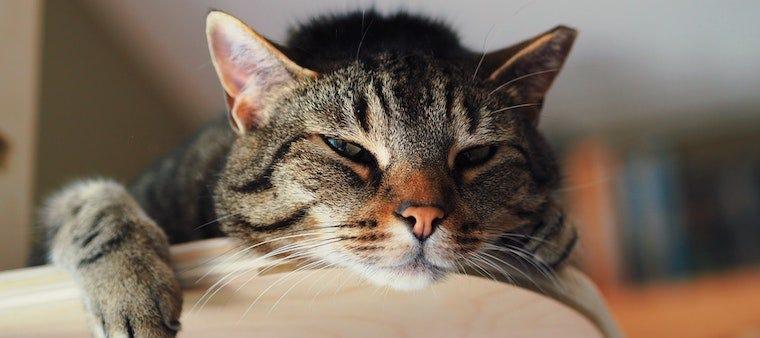Cat euthanasia is a difficult, devastating decision. Please know that whenever you have to consider it, your veterinarian is there for you.
When should I euthanize my cat?
Years ago, I lost both of my beloved cats within 5 days of each other. 5 days! Seamus, my 19.5-year-old cat, was diagnosed with a horrible mouth cancer called squamous cell carcinoma (SCC), despite surviving chronic kidney disease for years. Unfortunately, by the time I noticed my cat’s signs of abnormal licking of canned food, the cancer—which was slowly growing in the back of his mouth—had become quite malignant. After having it biopsied by the veterinary dentist, she warned me the survival with SCC was only approximately 5 weeks. 5 weeks! That’s all I had left to spend time with him.
So, I wanted to spoil Seamus as much as I could. After all, he had given me almost 2 decades of incredible, loving companionship. After his diagnosis of cancer, I considered each day thereafter “icing on the cake.” He got tuna. And shrimp. And filet. He got to drink half-and-half creamer and eat vanilla ice cream. He got meat-based baby food and bonito tuna flakes, and he loved his last 5 weeks. I wrote a blog about my cat’s journey with SCC, which you can also check out.
I also put Seamus on pain medication, an opioid called buprenorphine. He was already on gabapentin, another type of really safe pain medication for his osteoarthritis, so he seemed comfortable between these two. Most importantly, as a veterinarian AND a cat parent, I wanted to preserve his quality of life and to make sure he wasn’t in discomfort or pain from his cancer. So, the big question was: When should I euthanize my cat?
Assess your cat’s quality of life with 3 questions
As a veterinarian, I ask myself 3 questions when it comes to assessing a pet’s quality of life (QOL). These include:
- Is my cat in any pain?
- Is my cat acting abnormal?
- And, is my cat eating?
How do I tell if my cat is in pain?
Cats don’t show obvious signs of pain. While there’s a new “feline grimace scale” for pain monitoring that veterinary professionals use, keep in mind that this is very hard for a cat parent to notice. To me, signs of pain in a cat include the following:
- Being slower to jump and move
- Hiding
- Acting aloof or abnormal
Keep in mind that cats don’t typically shiver, whimper, shake, or cry out in pain the way dogs do.
To me, the biggest, most obvious sign of pain in cats is hiding. This typically means that something significant is going on.
As cats descended from big cats, they don’t show clinical signs of being sick until the medical problem is end-stage or very severe. Every day in the veterinary ER, I have to alleviate a lot of pet parent guilt. They feel like they missed some of the signs of illness in their cat. Now, don’t get me wrong—there are some signs, like drinking more, losing weight, having big clumps of urine in the litter box, vomiting more frequently, or becoming a more picky (or slower) eater, etc. If you notice those signs, you want to get to a veterinarian sooner than later. The sooner we diagnose a problem, the sooner we can treat it!
Is my cat acting abnormal?
The second big clue to me is if there’s abnormal behavior. Again, this is similar to the signs mentioned above like acting more aloof or more clingy, crying out more, hiding, not wanting to sleep in their typical places, to being slower to jump and move around. Keep in mind that some of these causes may be related to medical conditions like arthritis, hypertension, and cognitive dysfunction. These are treatable causes, once diagnosed! However, if your cat only wants to be in one room and away from the family, seems distressed, or is hiding, again, these may be signs of diminished quality of life.
Is my cat eating?
For me, quality of life is significantly impacted when your pet stops eating. When a cat stops eating, they also run into the medical problem of potential life-threatening complications of hepatic lipidosis. When Seamus was diagnosed with cancer, I tried to get him to eat whatever he wanted! He had a buffet of options to tempt him to eat. And there are actually veterinary-prescription appetite stimulants that you can use. These include medications like mirtazapine or a newer appetite stimulant, capromorelin (Elura). Mirtazapine is a once daily oral or transdermal (e.g., you put it on the inside, hairless part of the ear). The other appetite stimulant is an oral medication. However, if you tried the entire buffet and veterinary medications and your cat still isn’t eating, that’s a sign of diminished quality of life to me.
When you ask yourself these 3 questions, hopefully it’ll help guide you on the best decision for you and your cat. When in doubt, you want to check with your veterinarian too. They will be able to guide you based on physical examination findings. These include assessing how dehydrated your cat is, how pale their gums are, how much difficulty breathing they may have, what the feline grimace scale is, or how severe the disease is.
The biggest mistake I see? People waiting too long to euthanize their pet, as it’s such a hard decision.
I’ll tell you that I regret not euthanizing one of my family dogs earlier. And I’ll also tell you that I’ve never had a pet parent regret euthanizing too early—rather, too late.
What is cat euthanasia?
As for cat euthanasia, please know that it is pain-free. It’s typically an overdose of a drug called a barbiturate, which quickly stops function to the brain and heart within seconds. Some veterinarians will pre-sedate with other medications and give another injection first of propofol, an anesthetic.
You have several options
When deciding to euthanize, please know that you have several options. You can do it at your veterinarian, at a 24/7 emergency clinic (especially if you notice these signs in the middle of the night), or potentially even at home. There are now more veterinary hospice or at-home cat euthanasia services, where veterinarians will come to your home to euthanize.
I euthanized Seamus in the veterinary clinic. Five days later, I ended up euthanizing my other cat at home. She had acutely developed internal bleeding from an invasive cancer, and already had evidence of metastasis on X-rays. My family was at peace knowing that both were pain-free and had a good quality of life until the end.
When in doubt, please know that this is a very personal decision. I generally prefer to euthanize in the comforts of home, where your cat feels the most comfortable. Please also talk to your veterinarian, as there are at-home sedatives you can give orally prior to your veterinarian coming over. These include drugs like high-dose gabapentin and trazodone, or even acepromazine, and should be given 2-3 hours earlier. Please don’t give any other medications—over-the-counter or prescription human medications—without consulting with your veterinarian or the ASPCA Animal Poison Control Center first!
Can I let my cat pass away naturally at home?
Please know that most veterinary professionals don’t typically advocate for letting your cat die at home. Why? It’s often not fast enough nor pain-free (with the exception of an acute seizure or heart arrhythmia). While I had one of my own cats die at home, he had a heart attack and I was left feeling very helpless during the two minutes that he was dying. (It felt like 10 minutes, and was very distressing for me even as a veterinary professional.)
Most importantly, know that you have options when it comes to cat euthanasia. Talk to your veterinarian or veterinary technician about them. Consider having the procedure of euthanasia done at home, if available. Talk to your veterinarian about medications that you can give first at home for pain control. Discuss if you want to be present or not, and if you can bury the body or take your pet’s ashes home to bury or commemorate.
Sending you and your cat lots of peace during this tough decision.
Cover photo by Anh Duc on Unsplash





